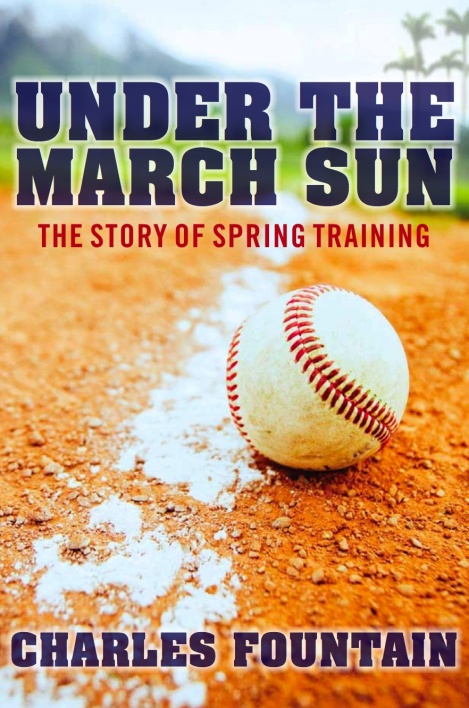Under the March Sun: The Story of Spring Training – by Charles Fountain
Legend has it that way back in 1885, a Chicago White Sox player walked into a Windy City bar, his vest bursting at the buttons after an off-season full of lots of good living – albeit apparently not full of preparation for the upcoming season. This player proceeded to consume somewhere between six and eight beers in the presence of his manager, Cap Anson, who upon seeing this decided that a pre-season trip to the hot south would be just the thing to get his players in shape for the upcoming season.
However, legend isn’t always fact, and the origins of spring training can be traced back even farther, to William Marcy “Boss” Tweed sent his team of amateurs, the New York Mutuals, to New Orleans prior to the 1869 season. But the fact that what is such an anticipated event today has a legend attached to it dating back some 114 years adds to the charm that is an annual right of passage into each new Major League season.
Like most things in baseball, the history behind spring training is much deeper and widespread that most people appreciate. What today is almost a formality given how well palyers take care of themselves in the off-season was a true necessity both in Anson’s day and through the better part of the late 1970s. In Under the March Sun, Charles Fountain weaves together the varied stories of the not just the goings-on at spring training, but the teams and towns that have crossed paths over the last 100-plus years, and how what we are witnessing at this moment is the product of an ultra-competitive game of musical chairs with tens of millions of dollars at stake.
Fountain uses a fairly chronological approach to his book, starting with the very early days of spring training, and moving onto more current day arrangements which dominate the latter half of the book. Fountain is quick to acknowledge the pains that came with early spring training – the financial losses teams had to absorb and racial segregation in the south that almost drove apart teams that were working on unity in the preseason. He brings names to life that most of us might not be familiar with – Al Lang and Joker Marchant, for instance, whose names are connected not just to stadiums but to the foundations of modern day spring training.
By using three teams as case studies, Fountain draws together the factors that have turned spring training into what it is today.
The first of which, the Minnesota Twins, shows how a solid working relationship between a city and team in the construction of a new facility could provide a tremendous boost to the bottom line of both parties. From that first spring training in 1991, the Twins and Fort Myers, Florida raised the bar and changed the trajectory that would chart spring training’s growth. The Twins’ story also shows the delicate balance between box score and bottom line, as Fountain notes in their chapter, “Feeding the revenue monster while also not compromising the special character that created the revenue monster is the challenge facing all clubs today.”
The second case study that Fountain looks at is the Atlanta Braves, who have utilized their facility in Orlando to create one of baseball’s longest runs of success – 14 straight NL East crowns. Their facility at Disney’s Wide World of Sports complex sets the tone for them to instill the Braves’ way of playing winning baseball amongst everyone in their organization, and combined with a staff who has stayed with the organization for years and even decades, has managed to produce an impressive roster of home-grown talent.
The Dodgers’ move from Vero Beach to the brand-new Camelback Ranch in Glendale, Arizona comprises the third major team analysis that Fountain presents. While Branch Rickey is often credited with the invention of spring training, it wasn’t him but rather Walter O’Malley who revolutionized spring training with the creation of Dodgertown in Vero Beach, Florida. But what became a piece of Dodger history for 60 years soon fell vacant after the club decided to relocate closer to home, and closer to a place where they could accomodate more fans and at higher revenues. Fountain’s extensive chronicling of the movement of the Dodgers is impressive – and rightfully so. Dodgertown was as much of an institution as almost anything in baseball, and the departure of the Dodgers is one that has quite possibly changed the landscape of spring training as we know it.
While Under the March Sun gives a tremendous look at “the story of spring training,” if I have to fault Fountain for anything, it would be a lack of coverage of the Cactus League. Being a West Coast fan, and having my team – the Mariners – in the Cactus League, I really wanted to know more about how it came to be. Fountain does dedicate a chapter to the league, and does spend a fair amount of pages on Arizona and how it has risen to prominence. And yes, I do appreciate that spring training has a longer history in Florida than it does in Arizona. But for those who have an interest in the Cactus League, be prepared to wait until page 163 to get to the real meaty content, and despite their being eight pages of photos, only one picture deals with the Cactus League – a photo of Dwight Patterson – the man credited with the formation of it in the 1950s.
To Fountain’s credit though, he made me want to learn more about the history of the Cactus League. Any time an author inspires me to learn more about a topic, it’s a check in the positive column. His coverage of the “Oasis League,” a third league proposed in Las Vegas, was also an engaging read, and a possibility that might become more and more realistic in the years to come.
Depending on your interest in learning about spring training as a whole, your interest Under the March Sun might vary. Certainly not every team gets equal amounts of coverage, and I found the book to be weighted more towards the Grapefruit League and the layout of things in Florida. However, as an overall look, it was very enjoyable and succeeded in surveying one of the best parts of the baseball landscape.
Fountain will take you into several aspects of spring training – economic, team development, and governmental, to name a few – and at the end leaves you with not just an eye on the present but one glancing into the unknown future. He reminds the reader that the whole spring training arrangement that we know today is still extremely fluid and subject to changes in the team’s wishes and economic direction. The call of the Cactus League sirens is extremely strong at the moment, having lured the Dodgers away from Vero Beach, the Indians back to the desert, and tripling the distance that the Cincinnati Reds travel to spring training – from a drivable 600 miles to Sarasota to an 1800-mile trek to Goodyear, Arizona. With teams on the hunt for the best deal and new communities looking for professional baseball to bring several weeks worth of revenue to their economy, “the spring training jungle,” as Fountain puts it, has “the line between predator and prey is thin and ever shifting.”


http://cgi.ebay.com/ws/eBayISAPI.dll?ViewItem&item=140457499974&ssPageName=STRK:MESELX:IT
we have a grapefruit plant on our home backyard and the fresh fruits taste so much better*`”
I don’t understand what you mean by that, can you elaborate it more?
We are the dealings sum for pensioners and children, the dealing u.s.a. for the and the sick… the craft north for the nation as a unit.
Yahoo! i want the item!
Maybe you could have thought of adding additional video clips about this topic to your blog posts to carry the guests further entertained? I imply I just read via the entire article of yours and it had been completely good high quality however since I am more of a visible learner,I discovered that to be extra useful nicely let me know how it seems! I take pleasure in what you guys are all the time up too. Such knowledgeable job and reporting! Keep up the nice works guys I’ve added you guys to my blogroll. This is a good article thanks for sharing this informative information.. I’ll visit your blog usually for some latest post.